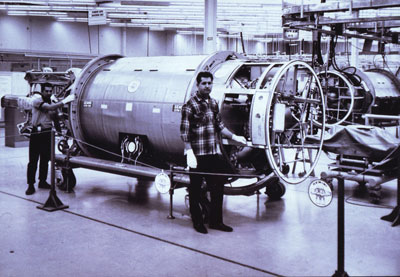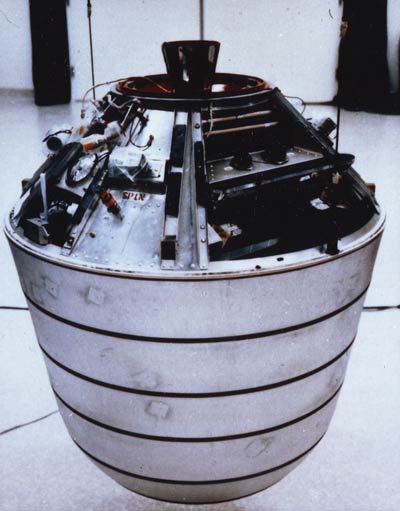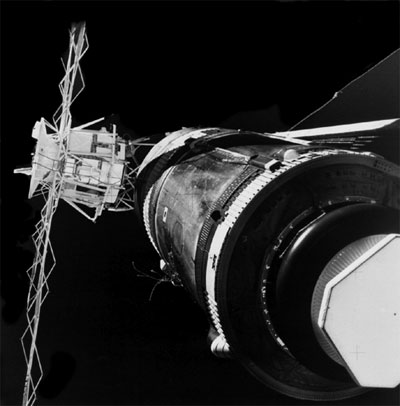Ike’s gambit: The KH-8 reconnaissance satelliteFROGIn the summer of 1966 the NRO initiated the study of a new reconnaissance satellite to try and satisfy the requirement for indications intelligence. Known as Film Read-Out GAMBIT and abbreviated as FROG, the system was to use the KH-8 GAMBIT camera and a modification of the read-out technique developed for the Samos E-1 and E-2 programs. The film would be developed in flight and scanned and then transmitted to a receiving station on the ground. It would produce ground resolution of three to five feet (0.9 to 1.5 meters). The satellite would have a lifetime of 30–90 days in orbit. Depending on the target, the satellite could return photographs as quickly as 20 minutes after it had taken them, or as long as five days later. In August 1966 the plan was to start formal development in fall 1966, with an initial operational capability in November 1968. Secretary of Defense Melvin Laird approved FROG despite its limited capabilities. Several of the scientists who advised the CIA and the NRO, as well as the CIA’s Director of Science and Technology, Carl Duckett, vigorously opposed Laird’s decision. They felt that approving a limited system at the time would postpone a far more capable “near-real-time” reconnaissance satellite that they felt could be achieved in several years. Although FROG had received top endorsement, it did not become ready by 1968. In fact it was not even ready in June 1971 when a top-level meeting of President Nixon’s intelligence advisors ultimately led to the cancellation of what had become a $2 billion program. Whether the delays with FROG were due to technology or bureaucratic politics remain unknown.
Extending the life of the KH-8In the early 1970s three young Air Force officers at the Air Force Satellite Control Facility in Sunnyvale California, more popularly known as “the blue cube” for its large blue glass building easily visible from Route 101, were on a covert mission, a mission so secret they were the only ones to know about it.
The officers had the job of tasking reconnaissance satellites. Back in Washington a special committee picked the targets for the satellites to observe and that list was sent to Sunnyvale, about an hour south of San Francisco. There these officers turned the target lists into a series of commands for the satellites and transmitted them to the satellites such as the KH-8. The commands told the satellites when to turn on their cameras, where to point them, and then when to turn the cameras off. It was common for the satellites to also take test photographs of known targets which could be used to indicate how well the cameras were working. A common target was Sunnyvale. One of the officers had an idea: why not program a photograph of Sunnyvale, and then stand out in the parking lot as the satellite took the picture? They would take the first self-portrait from space! So according to one of the former Air Force officers, that is what they did. They put in a request to their superiors for a test photograph of Sunnyvale. It was approved. They programmed the commands and transmitted them up to the satellite. At the appropriate time, when the sun was at a low angle casting long shadows, they went outside and stood in the parking lot, spreading their arms and legs in order to cast distinctive shadows. A few weeks later they had the photograph of Sunnyvale, nice and crisp. And visible in the parking lot were three figures casting long shadows. They had to wait of course because the KH-8 returned its film to Earth in reentry vehicles, and only after the reentry vehicles had filled up. The KH-8 initially had only a single reentry vehicle. Three KH-8s were launched in 1966 and seven in 1967 while the older KH-7 was still operating. Eight were launched in 1968 and six in 1969. But starting in October 1969 with the 23rd KH-8 launch, the last of the year, the KH-8 began operating with two SRVs. For simplicity, this author has arbitrarily designated this dual-SRV spacecraft the KH-8A, just as the dual-SRV CORONA was designated the KH-4A, but it is not known if this was the official designation. Two SRVs would have allowed the KH-8A to operate much like the KH-4A CORONA satellites. CORONA would usually operate for a day taking photographs and return its first SRV. It would then enter “zombie mode” with its systems shut down for up to two weeks. At the end of this period it would be reactivated and take additional photographs before ejecting its second SRV. The result was that the intelligence community gained twice the capability for the cost of only a single satellite. The lifetimes of KH-8 satellites had steadily increased over the years to approximately two weeks by late 1968. But in January 1970 the second KH-8A operated for 18 days in orbit, and the third KH-8A, launched in April 1970, operated for 21 days. Over the next several years KH-8A mission times increased slowly, from 21 days in spring 1971 to 22 days, 25 days, and finally to 33 days by December 1972. However, this longer lifetime most likely would have required the addition of solar cells to provide power, because a satellite could not have operated on batteries alone for three weeks or more. The KH-8A therefore probably had at least a single solar panel of the kind carried as an experiment aboard CORONA Mission 1115 in September 1971. In 1974 the NRO increased the lifetime of the KH-8A again. The agenda for the February 21, 1974 meeting of the Committee on Imagery Requirements and Exploitation, known as COMIREX, included a briefing on “Improved Orbital Capability for [deleted] Satellites.” This was undoubtedly a discussion of upgrading the KH-8, because the next mission had a lifetime 44% longer than its predecessor. A mission launched on June 6, 1974 spent 47 days in orbit, and a mission launched in March 1976 spent 57 days in orbit. The most obvious requirement for longer orbital life would have been more fuel for reboosting the satellite’s orbit, plus an increase in the amount of nitrogen control gas carried aboard the Agena. The Agena maintained its stability by using nitrogen gas jets and would have required more nitrogen during a longer orbital stay. Other changes are less obvious, but probably included other consumables such as longer-life batteries. And of course all of the hardware would have had to be tested and certified for longer time in orbit, such as more heating and cooling cycles. The next major leap in KH-8A mission duration coincided with the 48th launch, in March 1977. That spacecraft spent 74 days in orbit. The missions that followed steadily increased in duration as well: 76 days, 90 days, 112 days, 128 days, and 118 days. These increases would have required further hardware changes. The increase in mission duration was undoubtedly prompted by the debut of the KH-11 KENNAN real-time reconnaissance satellite. The KH-11 was the first electro-optical reconnaissance satellite, providing a capability that the American intelligence community had sought ever since the mid-1950s. Unlike its predecessors, the KH-11 was not limited by the amount of film or the number of recovery vehicles it carried. Instead, the KH-11 could operate in orbit for years, beaming photographs back to the ground electronically. The KH-11, which was approved by President Nixon in summer 1971, had effectively slain the FROG (Film Read-Out GAMBIT) and assumed the job of providing indications intelligence. The KH-11’s debut led to a major change in GAMBIT operations. GAMBIT remained in service for over seven years after the KH-11 became operational because it still provided high resolution photos of a quality that the KH-11 could not achieve from its higher orbit even with its bigger mirror. But the KH-11 could provide photographs of fairly high quality nearly instantaneously. It was used to cover many more of the GAMBIT’s targets, and the KH-8 was then used much more carefully to photograph only those targets where its high resolution could be of greatest value. There was probably another factor weighing against the KH-8 besides its technological obsolescence. By the early 1970s the Air Force had tentatively agreed to launch its satellites on the Space Shuttle. This meant that the satellites had to be compatible with the shuttle; able to handle the different noise levels and forces that would affect them during a shuttle launch and capable of surviving a landing inside the shuttle’s payload bay during a launch abort.
In 1973 Lockheed had proposed carrying up to three Agena spacecraft inside the space shuttle’s payload bay. This configuration would only be viable if the payloads were all headed for the same initial orbit. But the Agena itself would no longer be required to place a reconnaissance satellite into a low polar orbit, only to support it once there. In addition, flying three reconnaissance satellites simultaneously would have presented other problems, such as the requirement to store one or more of them in orbit for a long period of time until needed. Thus the KH-8 was not ideally suited for shuttle launch unless it was substantially redesigned, or the Agena was flown without much fuel. Carrying three KH-8s in a shuttle’s payload bay was an inefficient way to operate. The details of NASA-NRO negotiations over use of the Space Shuttle during the 1970s remain shrouded in secrecy (see “The spooks and the turkey”, The Space Review, November 20, 2006). The two agencies probably jointly agreed not to adapt the Agena upper stage for Space Shuttle use, although other satellites such as the KH-9 HEXAGON and the KH-11 KENNAN were clearly more adaptable to the shuttle. That decision to phase out the Agena would have started the clock ticking on the GAMBIT’s remaining years of operation.
From ASATs to SkylabIn addition to photographing ground targets—including junior Air Force officers—the KH-8 GAMBIT also demonstrated a unique capability. On May 14, 1973 NASA launched the Skylab Orbital Workshop atop its last Saturn V. During liftoff the workshop’s meteoroid shield broke loose and ripped off one of its two main solar panels. The space station entered orbit severely damaged. Major General David Bradburn, who was then the head of the Office of Special Projects, NRO’s Program A, proposed that a GAMBIT spacecraft planned to be launched on May 16 be used to take a photograph of Skylab to assist NASA in planning a repair mission. The manned Skylab 2 mission, which had now become a repair mission, was scheduled to launch on May 25, which probably meant that the first phase of the GAMBIT’s photographic mission would have to be cut short in order to return the photos earlier so they could be used for planning the repair mission. According to Bradburn, who spoke about the incident during an Air Force history symposium in 1995, he made the argument that Skylab was an American project and it was in the best interests of the nation that it not fail. This justified using an intelligence satellite to help save it, even if that undermined some of the intelligence collection. Bradburn’s proposal was approved by his superiors in the NRO and presumably by the Director of Central Intelligence and the Secretary of Defense. Bradburn was able to propose this mission because for approximately six months a group of junior Air Force officers in the Special Projects Office had been developing computer algorithms for using a GAMBIT to photograph Soviet spacecraft. Their effort had been instigated by Soviet tests of an anti-satellite capability. They wanted the capability to take a photograph of a Soviet ASAT vehicle if one ever approached an American spacecraft. Because the computer programs were ready, the NRO was able to respond quickly to the Skylab problem—something that Bradburn could tell his superiors.
According to one person who saw the photograph, the Skylab was only a small spot in the frame. It was also slightly blurry but still identifiable, and the photography was apparently still useable for NASA’s rescue mission. Considering that the GAMBIT strip camera had been designed to photograph a moving ground target, matching the film speed to a moving spacecraft in an entirely different orbit must have been challenging. But the mission contributed to the rescue of a billion-dollar space project—and it also demonstrated that not even Soviet satellites could hide from the prying eyes of American spysats. After this event, the United States would retain so-called satellite-to-satellite (or “sat-squared”) imaging capability. It was placed in a special security classification compartment known as “RUFF SENSITIVE,” or “RSEN” for short. In addition to sat-squared imagery, RSEN included other unusual and exotic capabilities demonstrated by American reconnaissance satellite cameras. Final days and HIGHER BOYKH-8 GAMBIT satellites continued to fly throughout the 1970s and into the 1980s. But on January 21, 1982 the Air Force launched a Titan 23B Agena D rocket into a 553 by 646 kilometer orbit. The perigee of this orbit was nearly three times as high as its predecessors. The unusual orbital parameters of this spacecraft led independent satellite observers to misinterpret this mission. One highly skilled British observer, the late Anthony Kenden, speculated that this was a test of a new radar reconnaissance satellite. But it was not a new satellite at all, and in fact was rather old. In reality, this was a launch of a specialized KH-8 satellite that had been sitting in storage for a decade and was now refurbished and launched as the program wound down. In the early 1970s NRO officials became concerned that the KH-9 HEXAGON area search satellite then under development to replace the CORONA might be late or not perform as planned once it reached orbit. They had already decided to stretch out the launch of remaining KH-4B CORONA satellites to cover the gap. But to guard against a potential interruption of search area coverage, the NRO also initiated a program called “HIGHER BOY” to fly a KH-8 GAMBIT at high altitude. At this high altitude the satellite would observe more area at lower resolution. A spacecraft modified to conduct this mission was produced and placed in storage. A decade later the NRO launched it into orbit. The overall success of the HIGHER BOY mission is unknown, but what is known is that one of the spacecraft’s two reentry vehicles failed to come down properly. From its higher orbit it lacked the power to reenter and stayed in orbit for a long period of time. The last GAMBIT was launched from Vandenberg Air Force Base on April 17, 1984 and operated for 118 days. It was the fifty-fourth KH-8 launch, and the twenty-ninth KH-8A launch. One KH-8 and two KH-8As had failed to reach orbit. Thirty-eight KH-7s had been launched, with two failing to reach orbit and three others failing to return imagery. The CORONA program had involved over 140 launches between 1959 and 1972. GAMBIT had involved 92 launches over nineteen years. GAMBIT’s legacyFor a decade now the intelligence community has sung the praises of its CORONA spacecraft. But it has been silent about the success of GAMBIT, which in some ways was more successful than CORONA, operating for nearly two decades as an effective counterpart to other lower-resolution search systems. According to several sources GAMBIT still holds the record for the highest resolution photographs taken in Earth orbit. In summer 1997, following upon the success of the CORONA declassification which had brought the American intelligence community in general and the National Reconnaissance Office in particular some much-needed positive publicity, the NRO leadership endorsed the declassification of the technical and programmatic details of the GAMBIT and HEXAGON programs. The NRO officially declared the film-return and other technology used in these programs obsolete and said that there was no further reason that they should remain classified.
But a declaration that there was no reason for something to remain classified is not the same as a declaration to declassify it and it is always easier for bureaucrats to deny something than to approve it. This recommendation languished for years and finally died, resulting only in the declassification of KH-7 imagery in 2002 and no technical or managerial details of either program. Such are the bizarre bureaucratic rules governing secrecy that today the designation KH-7 is unclassified, but the name “GAMBIT” is still classified, and although the KH-7’s product can now be viewed in the National Archives, the organizations that built it and its method of operation are still hidden from view. There may be many reasons for this secrecy, including continued opposition by Kodak to declassifying intelligence systems that the company helped build, continued opposition within the intelligence community to revealing even long-obsolete intelligence equipment, as well as an increased general atmosphere of secrecy started in 1998, but increased both by Bush administration policy and as a result of the terrorist acts of September 11, 2001. The Obama administration has promised change in a number of areas of government operations. One can only hope that a relaxation of arcane and archaic secrecy rules will allow President Eisenhower’s other great intelligence achievement, the GAMBIT satellite, to finally take its place in the sun alongside the U-2, the CORONA, and the signals intelligence satellite. Home |
|


